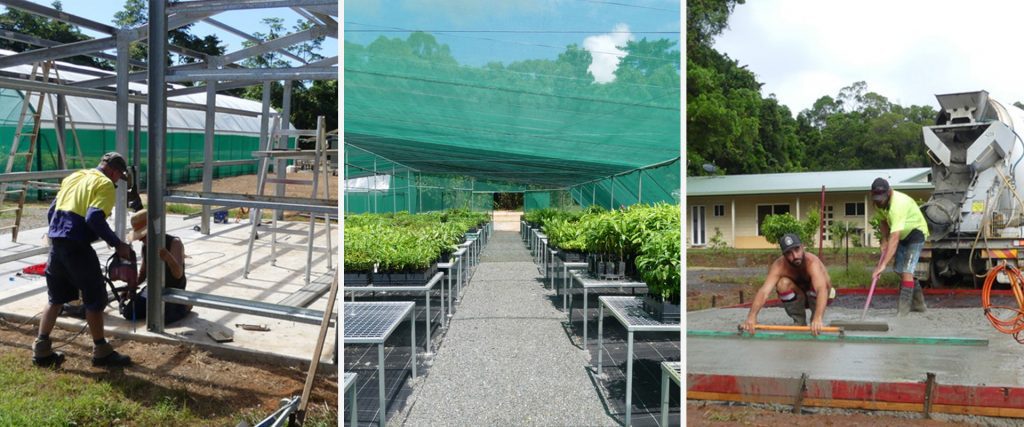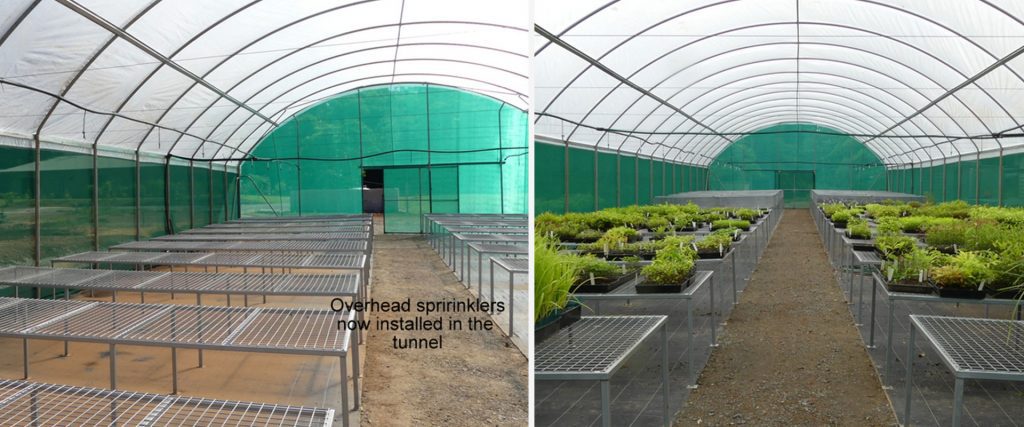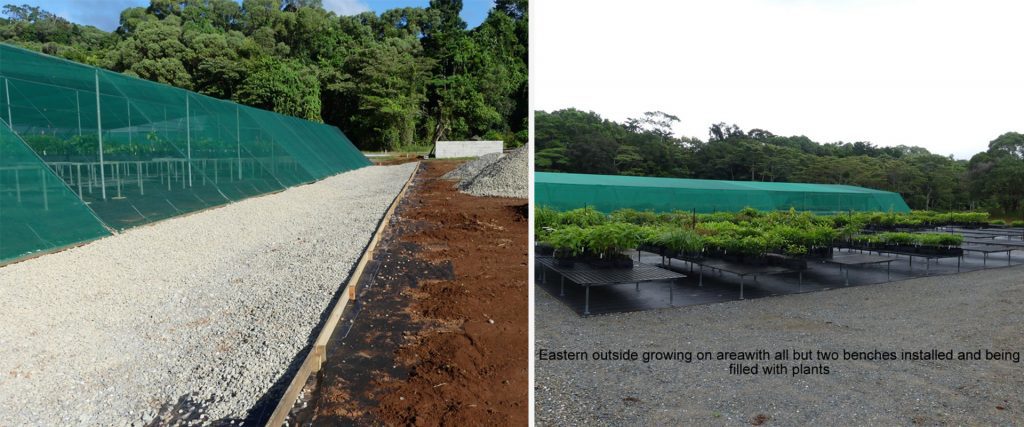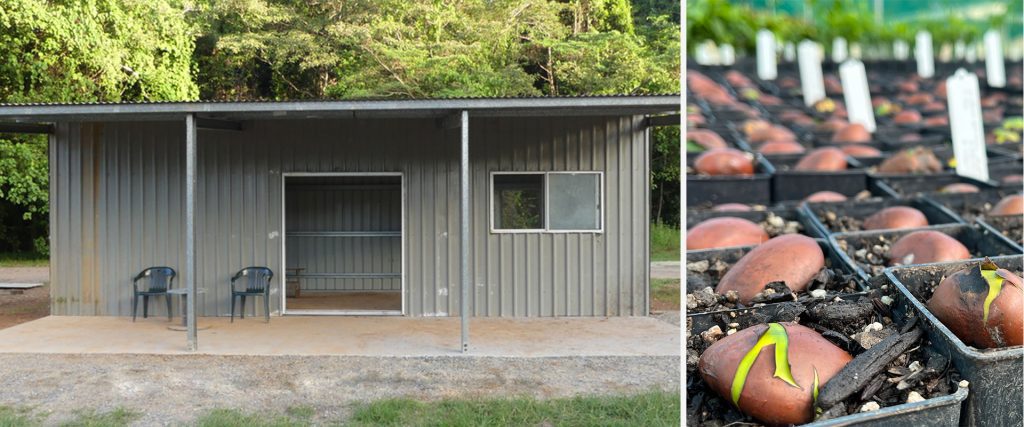Our new Native Nursery nears completion

With two new properties rescued, it’s high time we checked-in with an update from Rainforest Rescue’s new Native Nursery at Cow Bay.
Driving up to the Native Nursery gate, it’s apparent that this is not just a site nearing completion, but a site that is alive with people hard at work in the process of growing rainforest plants.
Our Nursery Team has been actively transitioning from our Diwan nursery to the new site since early 2023. Now we’re several months into the cycle of native seed collection, germination and growth of rainforest plants. In fact, our Land Management team is now planting at our properties with plants from the Cow Bay site. Such a good feeling!
Marine Deliens, Rainforest Rescue’s Nursery Manager, provided a quick update:
We’ve now grown over 25,000 plants in the new nursery, which is just over twice the capacity of our old nursery! This is an amazing milestone. The growing process from seed through to hardening-off ready for planting is working effectively and our success rate is extremely high, over 95%.”
Just imagine the buzz in the nursery when we reach our target production of 150,000 plants in a year!
Of course, to get to that point we still have several construction steps to go. Here’s a recap of the recent months with additional on-site perspective from our Project Manager, Allen Sheather.

Views of the newly constructed Propagation House as it fills up with rainforest seedlings
Increasing capacity
Throughout the nursery site we are increasing capacity. The seedlings within the Propagation House are regularly joined by new neighbours as the custom-built protective cages fill up with newly germinating plants. The design has been particularly effective at dissuading native rodents from taking their share of the nutrition that a germinating seed provides. While this acts as a good deterrent, it also minimises the risk of our location becoming a ‘honeypot’ for the local rodent population!
The multi-stage shadehouse is showing its value in ensuring that the plants can mature to a point of coping with the tropical sunshine. One look through the double doors and you notice the gentle nod of hundreds of pioneer plants craning towards the sunlight. Dozens of different rainforest species have now been grown in the new Native Nursery, which helps our Land Management team to plant out restoration sites with a strong mix of growth-phase species and encourage a biodiverse habitat.
Outside in the first hardening off area we’re reaching a point of capacity already! This is great to see, as its proof of the increased scale of growing capability, as well as the need for our second, larger area for hardening off plants.
This new area is now levelled off and the digging of drainage channels is almost complete. To give a sense of scale, our current hardening off area and the one at our previous nursery comfortably fit within this new area! And there’s still room for more native plants… Wow.
We had been having the odd light shower of rain, often causing us to sit it out for a bit, but of course once the verandah roofing was up and we had a dry place to work the sun came out and it stopped raining. Go figure.”
Allen Sheather, Native Nursery Project Manager

A spoon drainage channel running alongside the Shade House gently guides rainwater to a purpose-built catchment area; The Hardening Off area is one of two at the new Native Nursery.
Water matters
With such a busy site comes the potential for increasing pressure on the area’s natural resources, especially water.
You’ll notice from the recent photos from the nursery construction that a lot of attention has been paid to drainage and water reuse and recycling. Spoon drains near to the shadehouse gently feed water back towards a purpose-built ‘bio retention basin’ which will capture water that we are recycling organically, fed by the system of drainage pipes throughout the site. These pipes then take water back through to the irrigation of the plants. Water management on the site also considers the heavy tropical rain, so our drainage system minimises the risk of site flooding and waterlogging.
Our approach has a two-fold benefit of minimising the need to extract any further water from the local area, especially during dry periods, and providing a closed system to minimise the risk of any environmental effects from our plants and their soil nutrients. While all our plant species are native to the Daintree region, we are cognisant of any impact our actions could have within the local environment.
Keeping the plants well-watered is one matter, ensuring the appropriate biological needs of our nursery team are adequately catered for in a sustainable manner is another. Which is longhand for saying we’ve now installed the composting toilet block!
Local footprint
Grafting on to John Donne’s maxim, “No infrastructure development, like our new Native Nursery, is an island.”
As we’ve previously mentioned, the impact of the nursery’s increased capacity within the local environment means water, wildlife and our ability to generate the higher volumes of plant growth must be assessed.
The Nursery team are using an ethical seed collection policy to minimise stress to the nearby rainforest ecosystem. Our seed collectors gather no more than 20% of any species’ seeds at any site. This leaves adequate amounts for germination, attrition and as a food source.
This low ratio also increases our focus on genetic diversity, especially where an endemic species has a restricted range, to help foster stronger and more resilient plant populations.
In time we aim to develop our own ‘seed banks’ of reforestation, so that our seed collectors can add further sites to their mix.

Providing shade, shelter and space to document the plants grown at the new Native Nursery, thanks to our repurposed shed; Black bean (Castanospermum australe) seeds are a key rainforest species growing in the Shade House.
Upgrades and additions
Perhaps the most visually significant recent addition to the site is our repurposed (and kindly donated) Nursery building from a site near Barrett Creek.
The project team spent some time rematching fittings and fixtures, as the reconstruction of this shed appeared near the centre of our Native Nursery site. This building will be our operations base for the Nursery. The cataloguing and management of hundreds of distinct species and many thousands of different plants requires an upgrade in our processes too!
And finally, there’s one incredibly special surprise that we can’t reveal just yet… We’re keeping our powder dry on it until the official opening of the new site. All we’ll say is our soil bunker will be a point of conversation (and selfies!) in the future.
These final additions mean that Rainforest Rescue’s new Native Nursery — YOUR new nursery — is nearing completion. It’s so exciting to realise that the results of our efforts will be ground-breaking. None of this would be possible without the immense belief you have in Rainforest Rescue. It fuels our drive to deliver on what we have promised to our supporters, the local community and the rainforests.
It’s such a pleasure to be sharing an update like this with you.
Want more good Rainforest news in your life?
Subscribe to our eNews | Follow us on Instagram | Like us on Facebook | Subscribe to our YouTube channel
Help Protect Rainforests Forever
Donate to Protect Rainforests Forever | Become a Rainforest Guardian | Partnership Options

